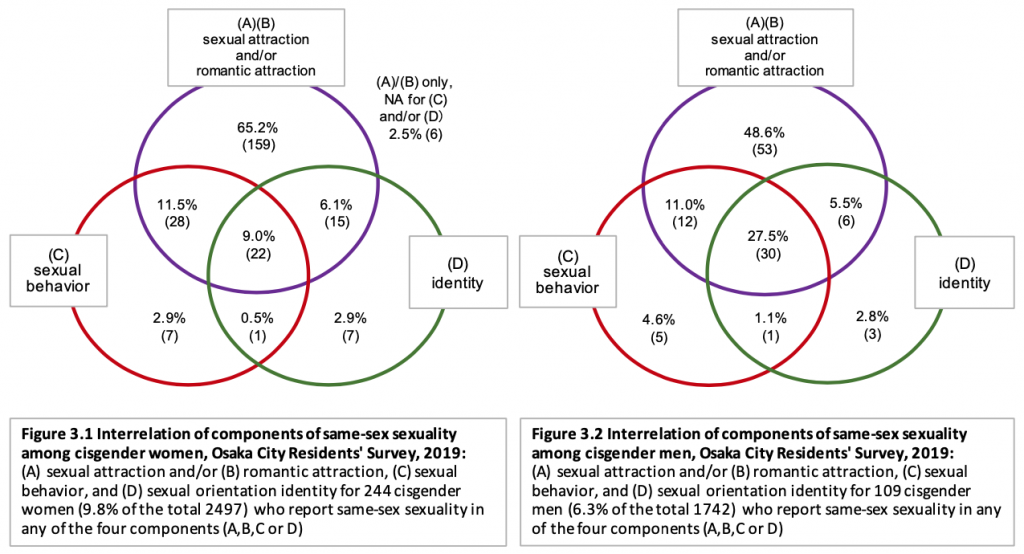I’ve just posted a working paper “Understanding Sexual Orientation Identity, Sexual/Romantic Attraction, and Sexual Behavior beyond Western Societies: The Case of Japan” on SocArXiv!
- Hiramori, Daiki, and Saori Kamano. 2020. “Understanding Sexual Orientation Identity, Sexual/Romantic Attraction, and Sexual Behavior beyond Western Societies: The Case of Japan” (https://doi.org/10.31235/osf.io/ds8at).
Abstract: As a growing amount of research examines the impact of sexuality on various demographic outcomes, it becomes important to understand the complex intersections of sexual orientation identity, sexual/romantic attraction, and sexual behavior. However, most previous studies use data from Western countries that have particular histories of sexuality, limiting the generalizability of the findings beyond Western societies. We describe dimensions of sexuality in Japan, where there has not been any religious authority condemning same-sex behavior and any law prohibiting same-sex relations except for a decade in the late 19th century. We use data from the “Survey on Diversity of Work and Life, and Coexistence among the Residents of Osaka City,” the first population-based survey with detailed questions about multiple aspects of sexuality in Japan, to conduct descriptive analysis. More women identify as bisexual or asexual than lesbian. Among the respondents who selected “Don’t want to decide, haven’t decided”—a category originally created for queer/questioning respondents—as their sexual orientation, the proportion of those who indicated exclusive heterosexuality is higher than expected, raising the possibility that some heterosexual respondents with no heterosexual identity may have mistakenly chosen this category. The data suggest that the population of heterosexual-identified men who have sex with men is small. The prevalence of the asexual population differs by whether sexual orientation identity or sexual/romantic attraction is used to capture this population. Our analysis extends the demography of sexuality by examining unique non-Western data and putting in context the previous findings observed in Western countries.
Keywords: asexual, demography, Japan, population-based study, queer/questioning, sexuality, sexual minorities
このたび、性的指向アイデンティティ、性的魅力・恋愛感情、性行動の相互関連性に関するワーキングペーパーを公開しました。おそらく日本における無作為抽出調査データを用いて性的指向の複雑性に関する分析を行った初めての人口学的研究だと思います。英文ですが、ご関心のある方はぜひご覧ください!
- Hiramori, Daiki, and Saori Kamano. 2020. “Understanding Sexual Orientation Identity, Sexual/Romantic Attraction, and Sexual Behavior beyond Western Societies: The Case of Japan” (https://doi.org/10.31235/osf.io/ds8at).
要旨(参考訳):近年さまざまな人口学的アウトカムに対するセクシュアリティの影響を検討する研究が増えている中、性的指向アイデンティティ、性的魅力・恋愛感情、性行動の複雑な相互関連性を理解することが重要になっている。しかしながら、ほとんどの既存研究では特定のセクシュアリティの歴史を持つ西洋諸国における調査データを用いているため、西洋社会を超えて知見を一般化することが困難である。そこで本稿では、同性間での性行動を非難する宗教的権威が存在せず、19世紀後半の10年間を除いて同性間での性的関係を禁止する法律が存在しない日本におけるセクシュアリティの諸相を描写する。具体的には、日本で初めてセクシュアリティの複数の側面について詳細にたずねている無作為抽出調査である「大阪市民の働き方と暮らしの多様性と共生にかんするアンケート」を用いて記述的分析を行う。分析結果として以下のことが示された。レズビアンと自認している女性よりもバイセクシュアルやアセクシュアルと自認している女性の方が多い。元々クィア・クエスチョニング回答者向けの選択肢として作られた「決めたくない・決めていない」を選んだ回答者のうち、他の性的指向指標において異性のみへの指向を示している人の割合が予想よりも高く、自らが異性愛者であるというアイデンティティを持ってない異性愛者の一部がこの選択肢を誤って選んだ可能性がある。男性と性行為をする異性愛自認男性の人口は少ないことが示唆された。アセクシュアル人口の割合は、性的指向アイデンティティまたは性的魅力・恋愛感情を用いるかによって異なることが分かった。本研究は、貴重な非西洋社会における調査データを検討し、西洋諸国で観察された既存の知見をより広い文脈に置くことを通じて、セクシュアリティ人口学に貢献していると考えられる。
キーワード:アセクシュアル、人口学、日本、無作為抽出調査、クィア・クエスチョニング、セクシュアリティ、セクシュアル・マイノリティ

